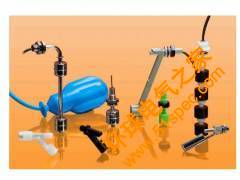
Overview
A float switch is a type of level sensor, a device most commonly used to detect the level of liquid within a tank or other
receptacle. A float switch is one of the most simple, reliable and well proven technologies for liquid level sensing. Float switches
are available in many different types and configurations, each suited to different applications. For example, a float switch may
be used as an alarm, as an indicator, to control a pump, or to provide a signal to another device. Like other switch types, float
switches can be electrically either normally open or normally closed. They can also be configured to have either single or multiple
switching points.
Uses
For applications requiring a repeatable signal indicating that fluid has reached a predetermined level, the float switch is often an excellent solution. Take for example a
tank containing a fluid that must be maintained between a minimum and maximum
level. When the fluid level reaches the minimum level, a float switch can be used
to signal a pump to operate and replenish the tank. When the fluid reaches the
maximum level, a float switch can be used to signal the pump to stop working. In this
way, the fluid in the tank remains within the required level range. This is a very simple
example and it should be noted that float switches can be specified to provide
significantly more complex level control options. However, if the sensor is required to
do more than simply initiate an action at a specific level (or levels), then a float switch
may no longer be the best solution. The same is true for any point level technology.
Function
Cynergy3 float switch units rely on reed switch technology for their switching action.
A magnet is mounted within the float and a reed switch is mounted within the body
of the unit. When a change in fluid level moves the float and brings this magnet into
close proximity with the reed switch, the switch will change state. If the reed switch is
normally open, the magnet will close the switch. If the reed switch is normally closed,
the magnet will open the switch. This N/O or N/C option allows the user flexibility in
their electrical circuit design. Float switches may have multiple floats and / or multiple
reed switches. This allows the float switch to provide multiple switching actions within
a single unit. For example, a single float twin switch or a twin float twin switch unit can
provide both maximum and minimum level signals.
Considerations
When considering what type of float switch to employ, it is vital to understand the application into which the switch is to
be introduced. important factors are:
? The fluid level state (or states) that require a signal from the float switch.
? Electrical load to be switched: Voltage, Current, Power, resistive, capacitive or inductive.
? The fluid type (to ensure chemical compatibility). Cynergy3 float switches and associated gaskets and seals are
available in many materials to give a broad range of suitability.
? Working temperature and pressure.
? Mounting type: Horizontal or vertical, external or internal. Space available within the tank.
? Cable and connection: Flying lead or connector, cable length and type.
? Approvals required: WRAS, ATEX, UL, NSF, etc.
? Likelihood of deposit build up.
Types
The choice of float switch types that may suit an application will depend on the
physical arrangement of the tank itself, the available mounting positions and whether
access is available to the inside of the tank. The main types are horizontal / side
mounting and vertical mounting. The horizontal / side mounting type normally has a
fixed housing, passing through the sidewall of the tank and including a hinged float
attached to the housing. Vertical mounting types normally have a fixed vertical stem,
which is installed through the top or bottom of the tank and include a cylindrical float
that slides along the stem. Many variations on these mounting options are possible.




